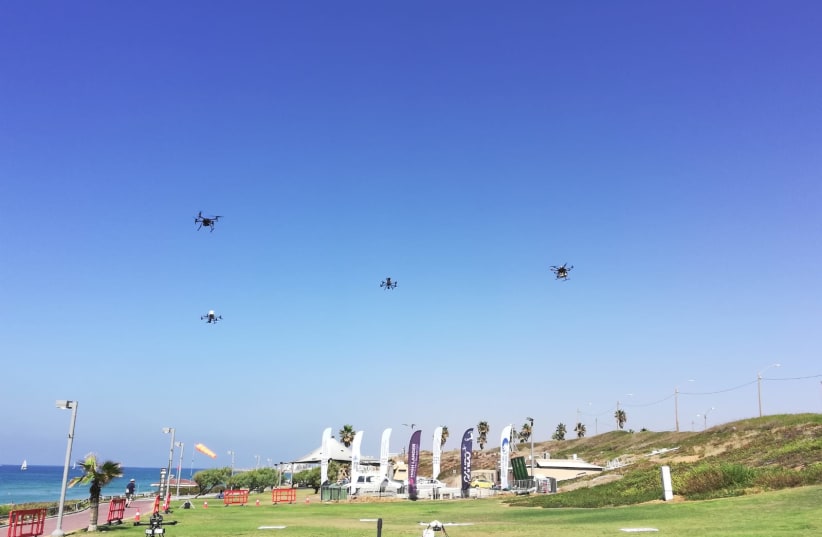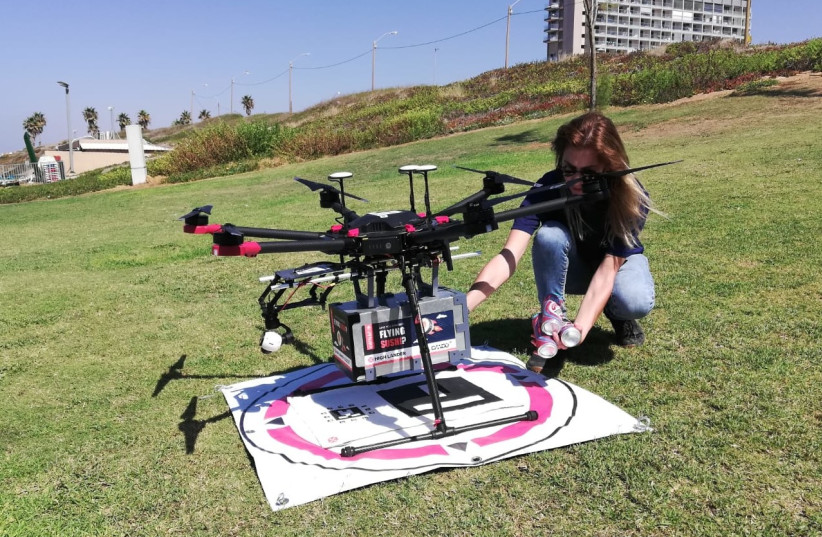Is the world headed for a time where takeout food, emergency medical supplies, and everything in between are delivered by drones, flying throughout the skies? And if so, what will that mean for our personal privacy, security and sanity?
An Israeli government-led project is looking to provide answers to these questions in what is now the most advanced national drone pilot project in the world.
The National Drone Initiative is testing whether a centrally coordinated network could create a viable new transportation mode that could track hundreds of autonomous drones making deliveries around the country at the same time.
Like an air traffic control center at an airport, the drone initiative’s central control center would manage and supervise the whereabouts of every authorized drone in the area, directing traffic, prioritizing drone routes, and clearing airspace when needed.
The goal is to enable a world where drones are used to deliver everything ranging from emergency medical supplies and military gear to pizza and ice cream.
These are all autonomous, self-guided drones, guided by technology with no human intervention, and coordinating large fleets of them over residential neighborhoods is a unique challenge.
There are similar tests being done elsewhere in the world, but Israel’s program is by far the most advanced, said Daniella Partem, who leads the project as head of the Center for the Fourth Industrial Revolution (C4IR).
“Why would people want to use drones for deliveries?” Partem asked, as she presented the program to a group of journalists this week. “They have zero emissions, and are environmentally friendly. They would reduce the need for freight vehicles on the ground, and the congestion they cause. They can travel quickly and reduce the wait time for urgent deliveries. The airspace is available, the technology is ready, and regulators are ready to embrace the changes required.”
The National Drone Initiative is a collaboration established last year between the Israel Innovation Authority, the Transportation Ministry (through the Ayalon Highways Company), the Civil Aviation Authority and the Smart Transportation Authority.
Over the course of two years, the project team is conducting a series of eight increasingly more complicated technological missions, with the goal of developing the experience and know-how to deploy the first functioning drone network in the world.
“Our mission is to establish a balance between safety, competition and regulation to create the future,” said Partem. “Safety, because everyone is concerned about the dangers of 25-kilogram drones flying around above us. Competition, because we believe that if this will be a service for all the people, we’ll need an economically viable, competitive ecosystem. And regulation, because all this requires creating the right regulatory environment.”
EARLIER THIS week, journalists were invited to observe a portion of the third of the eight missions, as drones delivered orders of sushi, beer and ice cream flying over residential areas in Tel Aviv-Jaffa.
This was part of a 10-day operation taking place above residential areas in Tel Aviv-Jaffa, Ramat Hasharon, Herzliya and Hadera. After the previous mission in June included flights over the city of Hadera, this was the first time flights were conducted over the country’s more populous central region. (Residents were given a phone number for any complaints they had about the noise from drone routes.)
About 300 flights per day were conducted, carrying out various kinds of tasks on flight paths assigned by the joint control system.
Eight private companies participated in the missions, in teams integrating the traffic control system solutions and the drones they operate.
Our tour started at the Ayalon Highways command center in Tel Aviv, where operators track the location of every drone on a huge wall full of various screens with maps, charts and coordinates. Identification details for each drone appear on the side of the screen, and visuals can be accessed from each drone’s camera. Flight routes are detailed on the screens, and no-fly zones are blocked out.
The drones fly in the airspace below 100 meters, considered very low by civil aviation authorities, explained Libby Bahat, head of the Aerial Infrastructure Department at the Central Aviation Authority.
For the purposes of the tests, the drones are allowed to carry up to 2.5 kilos, although they are capable of carrying more. The drones have a maximum speed of about 65 kph. Missions are being conducted within a 5-km. radius. Bahat noted that the tests are coordinated with the army, local municipalities and other organizations that need to be updated.
The entire infrastructure is being designed to allow the flexibility that will encourage competition within the field, added Sagi Dagan, vice president of growth at the Israel Innovation Authority.
One of the complicated issues that the team was struggling with was how to allow multiple traffic control systems from different providers to operate at the same time, instead of giving the monopoly to just one company.
“Ultimately, it is the businesses that will establish the use cases that will determine what works,” said Dagan.
After observing the command center, the group was taken to the North Tzuk Beach, the northernmost beach in Tel Aviv, for a live demonstration of a food delivery by drone, conducted by two of the participating drone operators, Cando and High-Lander.
An order was placed via the project’s restaurant app to the Japanika restaurant several kilometers away, where several bags of sushi were prepared and loaded into two drones (unfortunately, not enough to provide the group with lunch, this reporter was disappointed to learn).
Just as modern food delivery apps can show customers where their order is located in real time, this app can also show the view from the drone’s camera as it lifts off into the air and flies over the city.
The delivery arrived about 15 minutes after we ordered, faster than any service I’ve used.
The descent was noisy, but the drones eventually touched down exactly on their targets in the open space in front of us, and the sushi was taken out of the drones’ storage units and served.
Another drone came from a different location, bringing cold beers.
On a screen nearby, a video feed was shown of a similar operation being done in real time in Brazil, in a parallel operation managed completely from within Israel.
During the test, the Cando and High-Lander companies also had a drone performing autonomous emergency security missions for the nearby Reading Fire Station, in which the drone located at the charging station was activated autonomously.
After the first demonstration, we were taken to the Charles Clore Beach, at the south end of Tel Aviv, for a similar drone demonstration by two other companies, SkyLinx and FlyTech. This time, they delivered ice cream from Golda, and they ordered enough for everyone.
The drones traveled a route over the sea, so as not to pass over unauthorized residential areas, and once again touched down exactly on the target set for it. Curious beachgoers stood around snapping photos as the drones landed. The gourmet ice cream was still frozen when it arrived.
Other participating companies, including Simplex and DownWind, conducted flights over urban areas in the center of Tel Aviv during the testing. HarTech Technologies Ltd. and Airwayz performed urban flights over the Hadera area.
While journalists got to cover the day’s food delivery missions, serious business was happening elsewhere. Flights delivered donated blood, platelets and plasma from the Magen David Adom blood bank to Sheba Medical Center in Tel Hashomer, with the goal of verifying the method of packaging, flying and procedures so that they meet Health Ministry regulations. The goal of that project is to consolidate the procedures that other companies will be able to use at every blood bank and hospital in Israel when required.
ARE WE headed toward a world where the skies are dotted with drones, buzzing by our homes and invading our personal spaces as they deliver takeout food to our neighbors? Probably not.
“You have to understand that the vision some people had of a drone flying directly to your balcony to deliver a package – it’s not going to work that way anytime in the near future,” explained Udi Shamai, CEO of Pizza Hut Israel, who ran a drone delivery test with the initiative earlier this summer. “There are too many issues of privacy, noise and safety that need to be considered.”
Instead, more likely, drones will make deliveries to drop spots, like shopping malls and parking lots, which will be designated and approved for such use by drone operators and municipalities. From there, drivers will be waiting to pick up the pies and complete the delivery.
In any case, there are still many questions that have yet to be resolved.
Asked how she would respond to people who are skeptical of the drone initiative, Partem said, “Everyone should be skeptical. It’s a new technology, and we’re facing many, many challenges. But we see there’s so much potential for drone usage, and we’re creating the environment to find out how we can use this to benefit people.”


